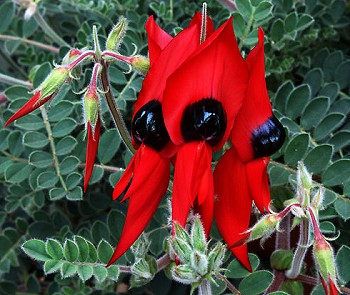
|
|
Sturt's Desert Pea - Swainsona formosa
|
Sturt pea - Swainsona formosa
Sturt pea, Swainsona formosa, is an Australian plant in the genus Swainsona, named after English botanist Isaac Swainson, famous for its distinctive blood-red leaf-like flowers, each with a bulbous black centre, or "boss". It is one of Australia's best known wildflowers. It is native to the arid regions of central and north-western Australia, and its range extends into all mainland Australian states with the exception of Victoria.
First discovered by the English explorer William Dampier on his 1688 visit to islands off the northwestern Australian coast, the plant's presence was noted by Australian explorer Charles Sturt in 1844 in areas between Adelaide and Central Australia. The flower was named after Sturt to commemorate his exploration of inland Australia.
The taxonomy of Sturt pea has been changed on a number of occasions. It was initially treated in the 18th century in the genus Clianthus as Clianthus dampieri, and later became more widely known as Clianthus formosus (formosus is Latin for "beautiful"). However it was later reclassified under the genus Swainsona as Swainsona formosa, the name by which it is officially known today.
Sturt pea is a member of Fabaceae, subfamily Faboideae. It has pinnate, grey-green leaves which are arranged spirally on the main axis of the plant, and in two opposite rows (distichous) on lateral stems. Its flowers are so different from its relatives that it is almost unrecognisable as a member of the pea family. The flowers are about 9 centimetres in length and grow in clusters of around half a dozen on thick vertical stalks (peduncles), which spring up every 10-15 centimetres along the prostrate stems, which may be up to 2 metres in length.
The plant flowers from spring to summer, particularly after rain. There is a natural pure white form, as well as hybridised varieties which can have flowers ranging from red to pink and even pale cream, with variously coloured central bosses. Several tricolour variants have been recorded, including
some cultivars. Flowers are bird-pollinated in the wild. The fruit is a legume, about 5 centimetres long, and each yields 50 or more flat, kidney-shaped seeds at maturity
Most forms of the plant are low-growing or prostrate, however in the Pilbara region of north-western Australia varieties growing as tall as 2 metres have been observed.
Generally considered to be a short-lived annual, it has been known to persist as a perennial if conditions are favourable. If the roots are left undisturbed, flowering may resume in the next season.
It is well adapted to life as a desert plant. The small seeds have a long viability, and can germinate after many years. Seeds have a hard seed coat, which protects them from harsh arid environments until the next rainfall, but inhibits germination in normal domestic environments. Growers can overcome this dormancy either by nicking the seed coat away from the 'eye' of the seed, by rubbing the seed gently between pieces of sandpaper, or by placing the seed in hot (just off-boiling) water and leaving it to soak overnight.
Boiling water should not be used as it destroys beneficial bacteria on the seed coat.
Once germinated, seedlings quickly establish a deep taproot, vital for desert survival. This means that if domestically grown, they should either be planted in their intended final location, transplanted as soon as possible after germination. They do not tolerate disturbance of their roots but, once established in well-drained soil, require little and infrequent watering, and can withstand extreme heat and sunshine, as well as light frosts.
Full sun, perfect drainage and protection from snails are essential. Supplementary watering may not be necessary once the seedlings are established. Under ideal conditions flowering commences about four months after germination. Sturt's Desert Pea is usually treated as an annual but vigorous flowering may result if root crowns survive from one season to the next.
Sturt pea is not endangered, but it is illegal to collect specimens of the plant from Crown land without a permit. The plants must not be collected from private land without the written consent of the land owner.
Sturt pea was adopted as the floral emblem of the state of South Australia on 23 November 1961. The iconic status of Sturt pea in Australia, and particularly in South Australia, has ensured its use as a popular subject in artwork and photography, as well as a decorative motif, and in a range of commercial uses. Sturt pea has also made many appearances in prose and verse, as well as featuring in some aboriginal legends (see Symon & Jusaitis (2007) for further details).
Sturt pea has appeared in several releases of Australian postage stamps depicting Australian floral emblems (issued in 1968, 1971 and 2005).
Source:
http://en.wikipedia.org/wiki/Swainsona_formosa
http://goaustralia.about.com/library/bldesertpea.htm
http://www.anbg.gov.au/emblems/sa.emblem.html
